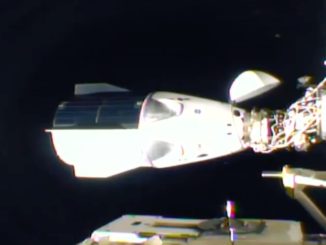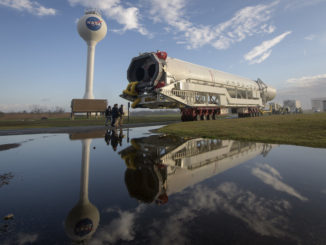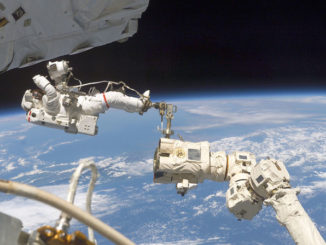
Ground crews transferred an Antares rocket out of an assembly building to a launch pad on Virginia’s Eastern Shore on Friday in a major step before liftoff Monday to resupply the International Space Station.
Mounted on a self-propelled mobile transporter, the rocket rolled out of a horizontal integration facility Friday afternoon and reached launch pad 0A at Wallops Island, Va., at nightfall after a one-mile journey.
Hydraulic pistons hoisted the two-stage rocket vertical on the launch pad overnight. Technicians planned to connect the rocket’s transporter, which also serves as a launch pad umbilical tower, to the launch pad’s electrical and fluid systems Saturday morning.
The Orbital Sciences Corp. Antares rocket and Cygnus cargo freighter are set for launch at 6:45 p.m. EDT (2245 GMT) from the Mid-Atlantic Regional Spaceport at NASA’s Wallops Flight Facility in Virginia.
Monday’s launch will mark the start of Orbital’s third commercial cargo flight to the orbiting research complex under a $1.9 billion contract with NASA. It will be the fifth launch of the company’s Antares rocket, which flew on two test flights last year before Orbital began commercial service in January.
Monday’s cargo liftoff will come two days after SpaceX, which has a similar resupply contract with NASA, is expected to conclude its fourth logistics run to the space station.
In an illustration of the hectic schedule of cargo and crew vehicles visiting the station, a Russian Progress supply ship will leave the complex Monday ahead of launch of another Russian cargo craft Wednesday.
A European Automated Transfer Vehicle is also currently docked to the space station.
Named the SS Deke Slayton after the Mercury astronaut and commercial spaceflight pioneer, the uncrewed Cygnus spaceship attached to the top of the Antares launcher is packed with 4,883 pound of cargo heading for the space station, the largest load of supplies and experiments Orbital Sciences has launched to the complex to date.
The cargo manifest includes more than 1,600 pounds of scientific equipment from NASA, U.S. companies and institutions, and international agencies. The Cygnus spacecraft’s Italian-built pressurized cargo module is also carrying 1,360 pounds of food, about 1,400 pounds of vehicle support equipment for NASA and Japan, 145 pounds of spacewalk gear, and 81 pounds of computer components.

Workers installed time-sensitive items into the spaceship’s barrel-shaped, 10-foot-diameter pressurized cabin earlier this week before covering the Cygnus spacecraft with the Antares rocket’s composite payload shroud Thursday.
Cranes lifted the rocket on top of its transporter-elector-launcher before Friday’s rollout from the horizontal integration facility.
The Antares launch team will complete final prelaunch closeouts on the Antares rocket and launch pad 0A over the weekend, including arming of the rocket’s solid-fueled Castor 30XL second stage, a test of the rocket’s steering system, the removal of handrails and work aids, and the closing of access doors on the booster.
A launch readiness review is scheduled for late Sunday morning to go over the status of launch preparations and give authority to proceed with the countdown.
The launch countdown will begin less than eight hours before liftoff Monday, with the opening of the Antares launch checklist at 11 a.m. EDT (1500 GMT).
The launch team will pump RP-1 and liquid oxygen propellants into the Antares rocket Ukrainian-built first stage Monday afternoon. The propellants will be consumed by the first stage’s twin AJ26 main engines, which were built in Russia in the 1970s, imported to the United States and upgraded with modern systems by Aerojet Rocketdyne.
The rocket’s computer-controlled terminal countdown sequence will begin three-and-a-half minutes before liftoff.
The Antares rocket’s AJ26 engines will power up to more than 700,000 pounds of thrust to propel the booster away from the launch site. Breaking the speed of sound as it arcs over the Atlantic Ocean, the Antares rocket will fire its AJ26 engines for nearly four minutes before letting go of the first stage to fall back into the sea.
The launcher’s payload fairing will jettison at an altitude of 81 miles — above the dense layers of the atmosphere — and the Antares will ignite a solid-fueled Castor 30XL upper stage motor made by ATK to send it into orbit.
The Cygnus spacecraft will deploy from the rocket about nine-and-a-half minutes into the mission, unfurl its Dutch-made solar panels, and begin its pursuit of the space station.
Officials opted to schedule the Antares launch earlier than necessary for the Cygnus spacecraft’s Nov. 2 docking opportunity, choosing to give the launch team multiple launch attempts and still preserve an on-time arrival at the space station.
Orbital spokesperson Barry Beneski said the company has reserved launch opportunities with NASA’s Wallops Flight Facility for Oct. 27, 28, 29 and 30.
The Cygnus spacecraft will approach the football field-sized station Nov. 2, carefully flying within 30 feet of the complex as astronauts take control of the lab’s robotic arm to reach out and capture the cargo capsule.
The spaceship will remain at the space station until around Dec. 3, when it will be released for a destructive re-entry in Earth’s atmosphere with trash and other unneeded items from the space station.
Follow Stephen Clark on Twitter: @StephenClark1.



